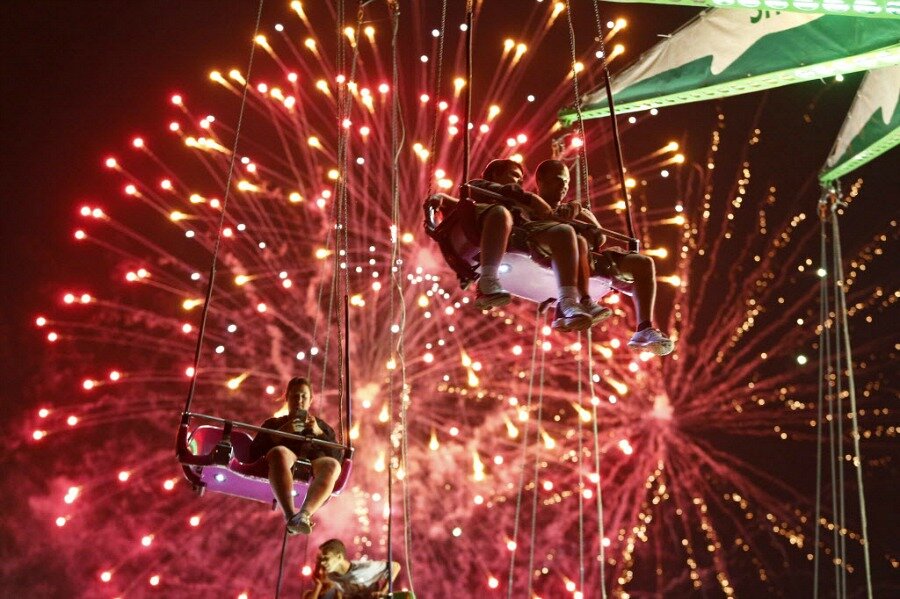As more states legalize fireworks, what's behind the pyrotechnic boom?
Loading...
| ATLANTA
Georgia is booming, literally.
Just in time for the Fourth of July weekend, Georgia axed its total fireworks ban, allowing a $700 million consumer pyrotechnics industry into the state for the first time in decades.
In the early 1990s, nearly 30 states had total firework sales bans. But after laws were relaxed this spring here in Georgia and in New York, that number is now down to three – New Jersey, Massachusetts, and Delaware. Since 2000, 12 states have liberalized their fireworks laws, even as fireworks contributed to a staggering rate of personal injury and fires, added to emerging concerns over fireworks pollution and even the effect of aerial repeaters and ground spinners on veterans with post-traumatic stress disorder.
In some ways, the impressive expansion of legal fireworks in part pits a muscular post-9/11 “rockets-red-glare” patriotism against a waning sense of safety and propriety.
Bottom line: Americans love to blow things up. And it’s that enthusiasm for gun powder that’s likely driving more and more states to trust residents with bottle rocket wicks, though retaining the ability to enact emergency bans during severe dry spells.
For Georgia Gov. Nathan Deal at least, signing a “heritage celebration” bill into law came down to common sense, given that all but one neighboring state has huge fireworks shacks right across the border.
“By and large, I think we acknowledge that citizens of Georgia are buying fireworks in adjoining states,” he told reporters when signing the bill this spring, effective July 1. “And the issue of safety is simply a question of whether or not somebody can afford to cross the state line and buy fireworks.”
To be sure, some conservatives say an era of what they call “nanny-statism” – a state focus on public safety over individual choice – began when states started to ban consumer fireworks in the 1930s.
But a more recent focus on public safety announcements plus the improved safety of the pyrotechnics themselves has yielded positive results. Even as US fireworks consumption has gone up from 29 million pounds in 1976 to 225 million pounds in 2014, the injury rate declined during the same span from 38 injuries per 100,000 pounds of pyrotechnics in 1976 to 4 injuries per 100,000 pounds in 2014, according to the American Pyrotechnics Association.
[Some say those safety improvements may have something to do with a bizarre public service announcement that took place in 1996, when Consumer Product Safety Commission chairwoman Ann Brown spent 20 minutes on the National Mall firing off M-80s and other fireworks taped to mannequins, with subsequent faux-gory results.]
But even as safety statistics suggest improvement, individual impacts of fireworks on human life and health remain substantial. After all, some 12,500 people around the US were injured last year by fireworks during the summer weeks around July 4.
In 2013, eight Georgians died while using fireworks bought in nearby states. And in Avon, Colo., nine people were injured Friday night when a set of rockets toppled over and fired into a nearby crowd instead of into the air. None of the injuries were life-threatening.
Critics also point to other emerging concerns about the boom in fireworks consumption. One is the fact that small-particle pollution increases 42 percent on the Fourth of July, across the country, according to the National Oceanographic and Atmospheric Administration (NOAA). That’s enough to impair breathing for some vulnerable individuals.
And heart-breakingly, a veterans’ group in Indiana called Military with PTSD this year launched an “Explosion of Kindness” lawn-sign campaign that lets neighbors be aware that: “Combat Veteran Lives Here Please Be Courteous With Fireworks.”
In a release, the group profiled Robbie Fulmer, a 40-something San Francisco Navy veteran, who says his diagnosis of post-traumatic stress disorder, a common battle veterans’ complaint, “has always left me on edge,” to the point where he’ll leave town for solo camping in the woods to get away from the Fourth of July cannonade. “The sound of fireworks explosions just increases that tension for me,” he says, according to the profile. “The irony is not lost on me that vets like me cannot celebrate our independence.”
The expansion of legal fireworks notwithstanding, many states and municipalities, especially in the West, spent the last few weeks before the Fourth of July setting up emergency bans.
Facing bone-dry conditions, Kerr County, Calif., for example, has temporarily banned fireworks in county-owned parks. And South Jordan County in Utah banned not just consumer pyrotechnics, but even the “flame-based devices” – matches and lighters – used to light the fireworks.
Fireworks do live up to their name. Fourth of July fireworks started 17,800 fires across the US in 2011, costing $32 million.
Pushing for a ban in King County, Wash. – a Seattle suburb – resident Bill Bowden complained to The Seattle Times that, on Fourth of July, “it’s impossible to tell the difference [in the town of Skyway, Wash.] between a holiday celebration and a battlefield.”








